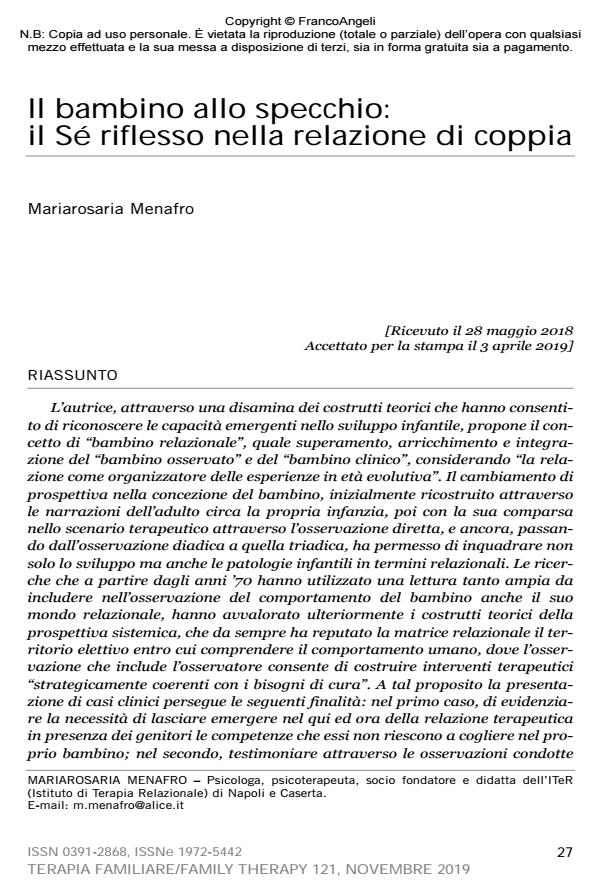Il bambino allo specchio: il Sé riflesso nella relazione di coppia
Titolo Rivista TERAPIA FAMILIARE
Autori/Curatori Mariarosaria Menafro
Anno di pubblicazione 2020 Fascicolo 2019/121
Lingua Italiano Numero pagine 21 P. 27-47 Dimensione file 96 KB
DOI 10.3280/TF2019-121002
Il DOI è il codice a barre della proprietà intellettuale: per saperne di più
clicca qui
Qui sotto puoi vedere in anteprima la prima pagina di questo articolo.
Se questo articolo ti interessa, lo puoi acquistare (e scaricare in formato pdf) seguendo le facili indicazioni per acquistare il download credit. Acquista Download Credits per scaricare questo Articolo in formato PDF

FrancoAngeli è membro della Publishers International Linking Association, Inc (PILA)associazione indipendente e non profit per facilitare (attraverso i servizi tecnologici implementati da CrossRef.org) l’accesso degli studiosi ai contenuti digitali nelle pubblicazioni professionali e scientifiche
L’autrice, attraverso una disamina dei costrutti teorici che hanno consentito di riconoscere le capacità emergenti nello sviluppo infantile, propone il concetto di "bambino relazionale", quale superamento, arricchimento e integrazione del "bambino osservato" e del "bambino clinico", considerando "la relazione come organizzatore delle esperienze in età evolutiva". Il cambiamento di prospettiva nella concezione del bambino, inizialmente ricostruito attraverso le narrazioni dell’adulto circa la propria infanzia, poi con la sua comparsa nello scenario terapeutico attraverso l’osservazione diretta, e ancora, passando dall’osservazione diadica a quella triadica, ha permesso di inquadrare non solo lo sviluppo ma anche le patologie infantili in termini relazionali. Le ricerche che a partire dagli anni ’70 hanno utilizzato una lettura tanto ampia da includere nell’osservazione del comportamento del bambino anche il suo mondo relazionale, hanno avvalorato ulteriormente i costrutti teorici della prospettiva sistemica, che da sempre ha reputato la matrice relazionale il territorio elettivo entro cui comprendere il comportamento umano, dove l’osservazione che include l’osservatore consente di costruire interventi terapeutici "strategicamente coerenti con i bisogni di cura". A tal proposito la presentazione di casi clinici persegue le seguenti finalità: nel primo caso, di evidenziare la necessità di lasciare emergere nel qui ed ora della relazione terapeutica in presenza dei genitori le competenze che essi non riescono a cogliere nel proprio bambino; nel secondo, testimoniare attraverso le osservazioni condotte nel setting le capacità emergenti di una bambina di cinque anni e specificamente quella di prefigurarsi le esperienze emotive future (mentalizzazione); nel terzo caso, di contribuire a una lettura sistemica circa lo sviluppo del bambino, con particolare riferimento alla dimensione multifattoriale nella costruzione del Sé e alla possibilità di coglierne le connessioni nella dinamica familiare: le descrizioni del caso clinico che coinvolge una piccola paziente di appena due anni, lasciano emergere continue risonanze con il trigenerazionale e allo stesso tempo, la bambina sembra rispecchiarsi nelle aspettative dei genitori, come se il Sé fosse riflesso nella relazione di coppia.
Parole chiave:Bambino relazionale, mentalizzazione, psicoterapia infantile, sviluppo del Sé, spazio triangolare, tecniche terapeutiche
- La magie de l’enfant dans la thérapie familiale pp.231 (ISBN:9782710146360)
Mariarosaria Menafro, Il bambino allo specchio: il Sé riflesso nella relazione di coppia in "TERAPIA FAMILIARE" 121/2019, pp 27-47, DOI: 10.3280/TF2019-121002